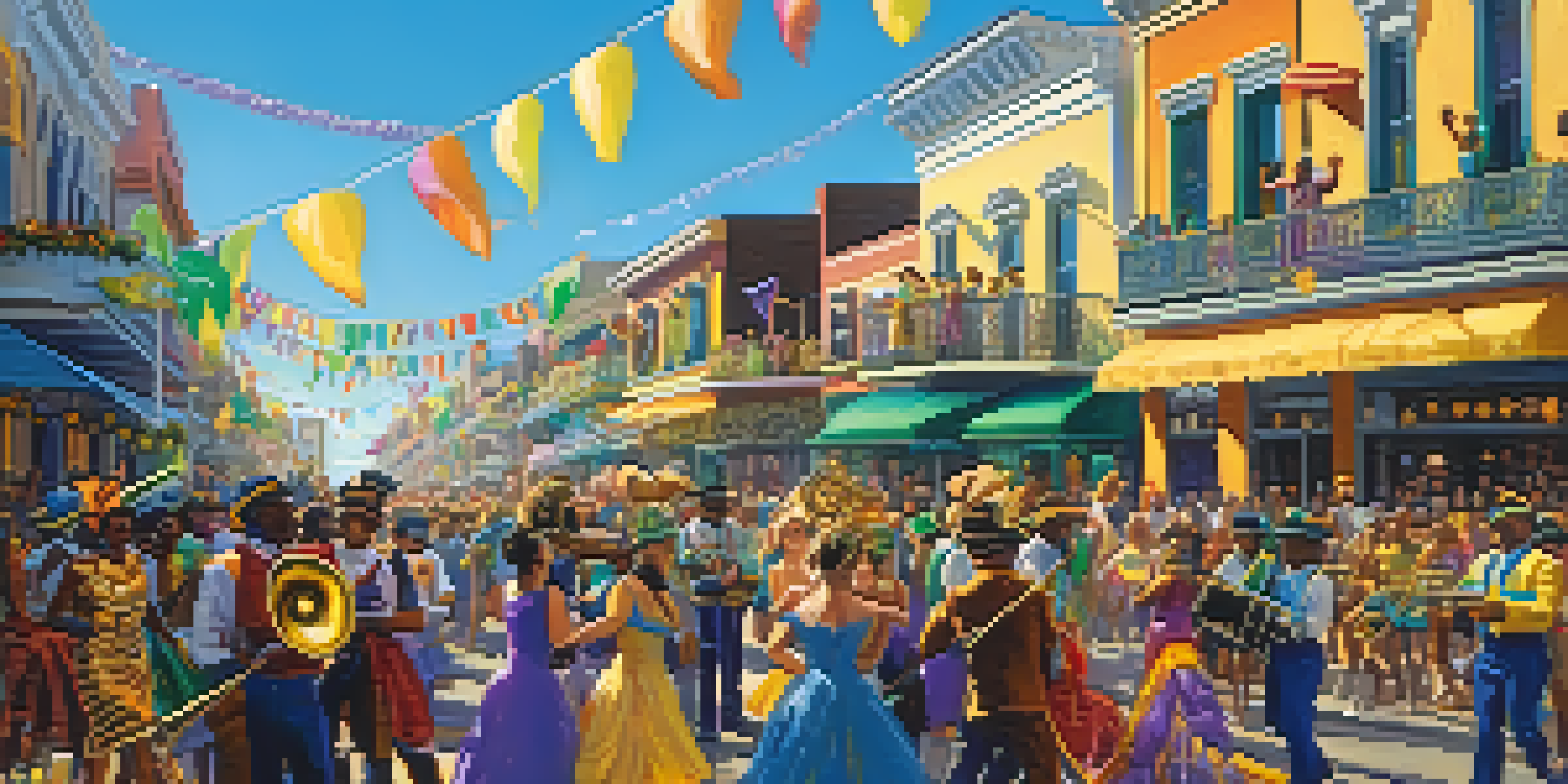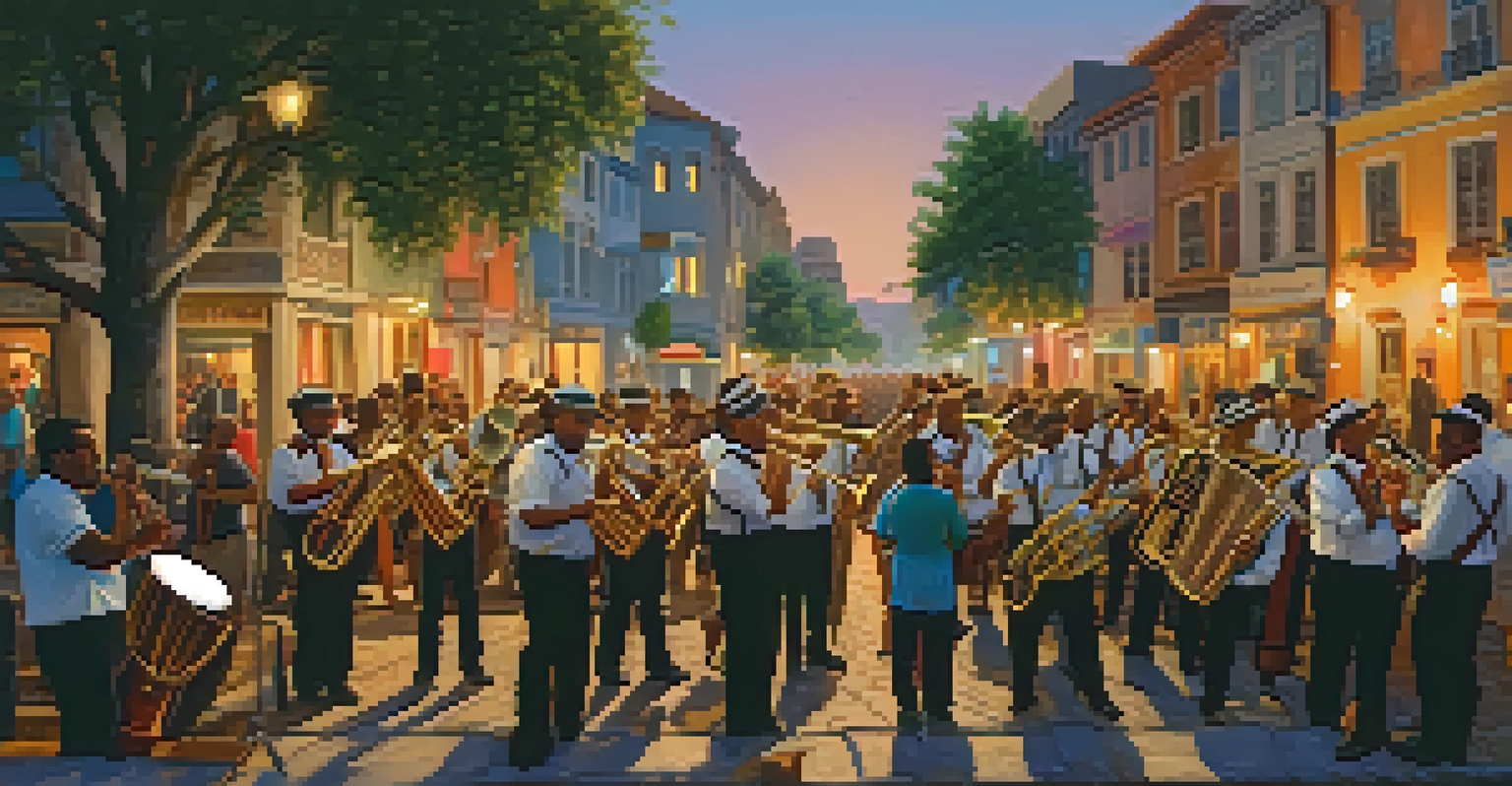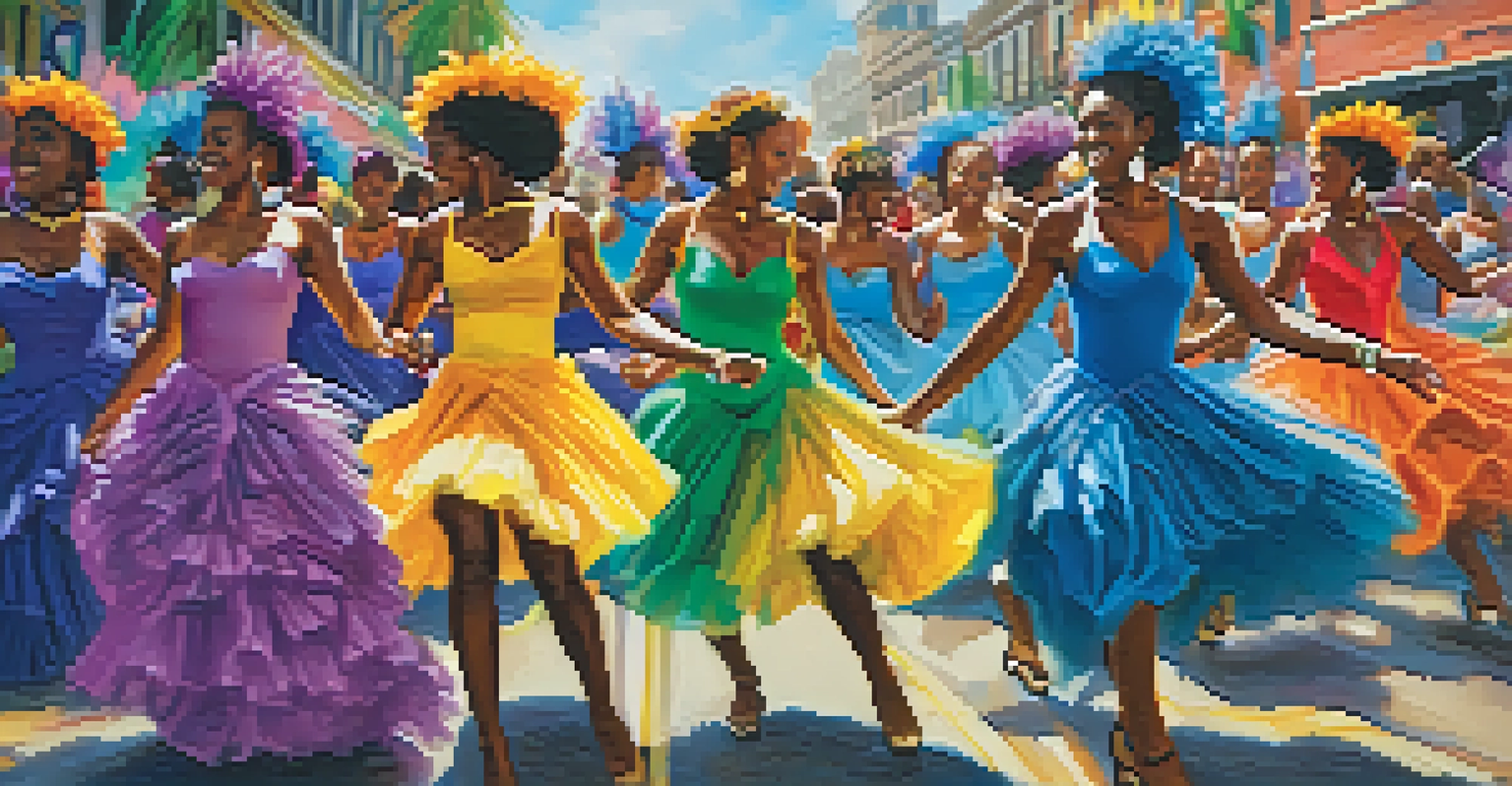Music and Dance: The Heartbeat of Mardi Gras Festivities

The Rich History of Mardi Gras Music and Dance
Mardi Gras, known for its lively parades and exuberant celebrations, has deep roots in music and dance. The festival's origins can be traced back centuries, blending influences from French, Spanish, and African cultures. As a result, the music reflects a vibrant mix of styles, from jazz to zydeco, creating a unique soundscape that sets the tone for the festivities.
Music is the shorthand of emotion.
Traditional New Orleans jazz, characterized by its improvisational flair, plays a crucial role in Mardi Gras celebrations. Musicians take to the streets, encouraging revelers to join in the rhythm, creating an atmosphere of joy and community. This spontaneous sharing of music enhances the sense of togetherness that defines Mardi Gras.
Dance, too, is an essential component of the celebration. Whether it's the energetic twirls of a traditional second line or the infectious sway of revelers in colorful costumes, dancing brings people together. It transforms the streets into a vibrant stage where everyone, regardless of age or background, can partake in the joyous expression of life.
Parades: A Melodic Showcase of Culture
One of the most iconic elements of Mardi Gras is the parade, where music and dance come to life in spectacular fashion. Floats adorned with dazzling decorations glide through the streets, accompanied by marching bands playing upbeat tunes. This harmonious blend of visual and auditory spectacle captivates both participants and onlookers alike.

Each parade showcases unique themes, with music selections that resonate with the spirit of the float. From classic jazz standards to contemporary hits, the soundtracks of these parades invite everyone to dance along. The rhythmic beats synchronize with the vibrant colors, enhancing the overall experience of the festivities.
Mardi Gras Celebrates Cultural Diversity
The festival blends music and dance from various cultural backgrounds, reflecting the rich heritage of New Orleans.
Dance troupes often accompany the parades, showcasing choreographed routines that reflect the cultural heritage of the community. These performances serve not only to entertain but also to educate attendees about the diverse traditions that make up Mardi Gras. As the dancers move in sync with the music, they embody the heart and soul of the celebration.
The Role of Traditional Instruments in Celebrations
Traditional instruments play a pivotal role in shaping the sound of Mardi Gras. Brass instruments like trumpets and trombones create bold melodies that resonate throughout the streets, while drums set the tempo for lively dancing. These instruments, often played by local musicians, infuse the celebrations with authenticity and energy.
Dance is the hidden language of the soul.
The presence of the accordion, particularly in zydeco music, adds a distinct flavor to the festivities. This instrument bridges cultural divides, inviting people from various backgrounds to dance together. Its lively tunes encourage spontaneity, turning any street corner into an impromptu dance floor.
Moreover, the communal aspect of music-making is evident during Mardi Gras. Local musicians often gather to play together, creating a sense of camaraderie that embodies the spirit of the festival. This collaboration not only keeps traditions alive but also fosters connections among residents and visitors alike.
Dance Styles and Their Cultural Significance
Mardi Gras features a variety of dance styles, each telling its own story and reflecting the diversity of the participants. From the lively footwork of the second line to the rhythmic movements of social dances, each style contributes to the overall tapestry of the celebration. These dances are not just for entertainment; they carry cultural significance, often rooted in history and tradition.
The second line dance, for instance, is a quintessential part of New Orleans culture. Originating from jazz funerals, it has evolved into a joyful celebration where participants follow a brass band, dancing freely. This dance symbolizes community support and togetherness, making it a perfect fit for Mardi Gras festivities.
Parades Showcase Community Spirit
Mardi Gras parades feature vibrant floats and live music, creating a joyful atmosphere that unites participants and spectators.
Additionally, the influence of Caribbean dance styles can be seen during the celebrations. The vibrant movements and colorful costumes reflect the cultural melting pot that New Orleans represents. By embracing these diverse dance styles, Mardi Gras showcases the rich heritage and unity found within the community.
The Influence of Modern Music on Mardi Gras
As time has progressed, modern music has begun to weave its way into the fabric of Mardi Gras celebrations. Contemporary genres like hip-hop, reggae, and electronic music have found their place alongside traditional sounds, attracting a younger audience to the festivities. This evolution keeps the spirit of Mardi Gras alive while appealing to new generations.
Local artists often blend traditional music with modern influences, creating unique sounds that resonate with both locals and visitors. This fusion not only enriches the celebration but also highlights the creativity of New Orleans musicians. The result is a vibrant soundscape that continues to evolve with each passing year.
Moreover, the presence of DJs and live performances in various venues during Mardi Gras provides additional opportunities for music lovers to engage. These events foster a sense of community and celebrate the diverse musical landscape of the city. As attendees dance to both classic and contemporary tunes, they contribute to the ever-changing narrative of Mardi Gras.
Community Engagement Through Music and Dance
Mardi Gras is not just a festival; it's a community celebration that thrives on participation. Music and dance play a vital role in encouraging individuals to come together, fostering connections that last beyond the festivities. From family gatherings to neighborhood block parties, the rhythm of Mardi Gras resonates in every corner of the city.
Many local organizations and schools participate in the celebrations by showcasing their talents through performances. These events provide a platform for artists of all ages to express themselves, reinforcing the importance of community involvement. By engaging in music and dance, participants not only celebrate their heritage but also create lasting memories.
Music's Lasting Impact on Community
The influence of Mardi Gras music and dance fosters ongoing connections and artistic collaborations that enrich New Orleans year-round.
Additionally, the spirit of giving back is evident during Mardi Gras. Many musicians and dancers donate their time and talents to raise funds for local charities, ensuring that the festival benefits the community as a whole. This sense of unity and shared purpose embodies the true essence of Mardi Gras.
The Lasting Impact of Music and Dance Beyond Mardi Gras
The influence of music and dance during Mardi Gras extends far beyond the festival itself. The connections made through shared experiences often spark lifelong friendships and collaborations among artists. Many musicians continue to perform together long after the celebrations, enriching the cultural landscape of New Orleans year-round.
Moreover, the skills developed through dance and music during Mardi Gras foster a sense of pride and accomplishment in participants. Local dance schools and music programs often see an increase in interest following the festival, as individuals seek to hone their talents. This ripple effect contributes to the preservation and evolution of the cultural arts in the community.

In essence, the heartbeat of Mardi Gras—its music and dance—creates an enduring legacy that shapes the identity of New Orleans. As the city continues to celebrate its rich cultural heritage, the impact of these art forms will remain at the forefront of its vibrant spirit.